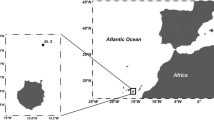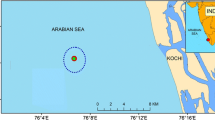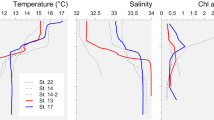Abstract
The influence of copepods (mainly Oithona sim-ilis) and krill (Euphausia superba) grazing on the species composition of plankton communities in ship board con tainers was investigated during the spring and post spring period in the Scotia Weddell Sea in the Antarctic ocean. Numbers of grazers were experimentally manipulated in containers with natural phytoplankton assemblages. With ratural levels of copepods but no krill a high (700–950 μg C·l1, ca 30 μg chl a·.l1) phytoplankton biomass developed. In these cultures large diatoms, e.g. Corethron criophilum and chains of Thalassiosira sp., made up 80% of total phytoplankton cell carbon at the end of the experiment. In cultures with elevated numbers of copepods (5X or 10X the natural level) phytoplankton biomass was somewhat reduced (ca 23 μg chl a · l1) compared to cultures with natural copepod abundance, but still high. Phytoplankton species composition was on the other hand greatly influenced. Instead of large diatoms these cultures were dominated by Phaeocystis pouchetii (70%) together with small Nitszchia sp. and Chaetoceros neogracile (20%). In containers with krill (both juveniles and adults), but without elevated numbers of copepods, phytoplankton biomass rapidly approached zero. With 10X the in situ level of copepods, krill first preyed on these before Corethron criophilum and Thalassiosira sp. were grazed. When krill were removed a plankton community dominated by flagellates (60–90%), e.g. Pyramimonas sp. and a Cryptophycean species, grazed by an unidentified droplet-shaped heterothrophic flagellate, developed. These flagellates were the same as those which dominated the plankton community in the Weddell Sea after the ‘spring bloom’. A similar succession was observed in situ when a krill swarm grazed down a phytoplankton ‘bloom’ in a few hours. Our experiments show that copepods cannot control phytoplankton biomass in shipboard cultures even at artificially elevated numbers. Krill at concentrations similar to those in natural swarms have a great impact on both phytoplankton biomass and species composition in shipboard cultures. Both copepods and krill may have an impact on phytoplankton species composition and biomass in situ since the rates of phytoplankton cell division were probably artificially increased in shipboard cultures compared to natural conditions, where lower growth rates make phytoplankton more vulnerable to grazing. A similarity between phytoplankton successions in containers and in situ, especially with respect to krill grazing, supports the conclusion that grazing may structure phytoplankton communities in the Scotia-Weddell Sea.
Similar content being viewed by others
References
Anon (1989) EPOS LEG 2 datareport, Hydrography, Part 1. NIOZ, Den Burg Texel, The Netherlands
Baar HJW de, Buma AGJ, Jacques G, Nolting RF, Treguer PJ (1989) Trace metals — Iron and manganese effects on phytoplankton growth. In Hempel I; Schalk PH, Smetacek V (eds) The ex pedition Antarktis VII/3 (EPOS Leg 2) of RV “Polarstern” in 1988/89. — Berichte zur Polarforschung, Alfred-Wegener-Institut für Polar und Meeresforschung, Bremerhaven, 65:34–43
Baar HJW de, Buma AGJ, Nolting RF, Cadée GC, Jacques G, Treguer PJ (1990) On iron limitation of the Southern Ocean: experimental observations in the Weddell and Scotia Seas. Mar Biol Prog Ser 65:105–122
Bennekom J van, Estrada M, Goeyens L, Magas B, Masson A, Morvan J, Treguer PJ, Svansson A, Veth C (1989) Distribution of nutrients m surface, subsurface and deep layers. In: Hempel I, Schalk PH, Smetacek V (eds) The expedition Antarktis VII/3 (EPOS Leg 2) of RV “Polarstern” in 1988/89. — Berichte zur Polarforschung, Alfred-Wegener-Institut für Polar und- Meeres- forschung, Bremerhaven, 65:47–55
Bergquist AM, Carpenter SR (1986) Limnetic herbivory: effects on phytoplankton populations and primary production. Ecology 67:1351–1360
Bedungen B von (1986) Phytoplankton growth and krill grazing during spring in the Bransfield Strait, Antarctica — implications from sediment trap collections. Polar Biol 6:153–160
Bedungen B von, Smetacek V, Tilzer MM, Zeitzschel B (1986) Primary production and sedimentation during spring in the Antarctic Peninsula region. Deep Sea Res 33:177–194
Boyd CM, Heyraud M, Boyd CN (1984) Feeding of the Antarctic Krill, Euphausia superba. J Crust Biol 4:123–141
Buma A, Estrada M, Larsen J, Riebsell U, Schloss I, Thomsen HA (1989) Unicellular organisms studied alive using photographic and video techniques. In: Hempel I, Schalk PH, Smetacek V (eds) The expedition Antarktis VII/3 (EPOS Leg 2) of RV “Polarstern” in 1988/89 — Berichte zur Polarforschung, Alfred-Wegener- Institut für Polar- und Meeresforschung, Bremerhaven, 65:102–110
Buma AGJ, de Baar HJW, Nolting RF, van Bennekom J (1991) Metal enrichment experiments in the Weddell-Scotia Seas: Effects of iron and manganese on various plankton communities. Limnol Oceanogr 36:1865–1878
Chavez FP, Buck KR, Coale KH, Martin JH, DiTullio GR, Welsc Hmeyer NA, Jacobson AC, Barber RT (1991) Growth rates, grazing, sinking, and iron limitation of equatorial Pacific phytoplankton. Limnol Oceanogr 36:1816–1833
Chisholm SW, Morel FMM (eds) (1991) What controls phyto- plankton production in nutrient rich areas of the open sea? Limnol Oceanogr 36:474 pp
Cullen JJ (1991) Hypotheses to explain high-nutrient conditions in the open sea. Limnol Oceanogr 36:1578–1599
Cuzin-Roudy J, Schalk PH (1989) Macrozooplankton — Biomass, development and activity. In: Hempel I, Schalk PH, Smetacek V (eds) The expedition Antarktis VII/3 (EPOS Leg 2) of RV “Polarstern” in 1988/89. — Berichte zur Polarforschung, Alfred Wegener Institut für Polar- und Meeresforschung, Bremerhaven, 65:146–159
Edler L (ed) (1979) Recommendations on methods for marine biological studies in the Baltic sea. The Baltic Marine Biologists Publication 5:38 pp
El-Sayed S (1984) Productivity of the Antarctic waters — a re appraisal. In Holm-Hansen O, Bolis L, Gilles R (eds), Marine phytoplankton and productivity, Lecture notes on coastal and estuarine studies 8:19–34
Eppley RW, Petersen BJ (1979) Paniculate organic matter flux and planktonic new production in the deep ocean. Nature 282:677–680
Fransz HG (1988) Vernal abundance, structure and development of epipelagic copepod populations in the eastern Weddell Sea. Polar Biol 9:107–114
Fransz HG, Gieskes WWC (1984) The unbalance of phytoplankton and copepods in the North Sea. Rapp P-v Réun Cons Int Explor Mer 183:218–225
Fransz HG, Gonzales SR, Mizdalski E, Schiel S (1989) Mesozoo- plankton — Distribution and development of copepods. In: Hempel I, Schalk PH, Smetacek V (eds) The expedition Antarktis VII/3 (EPOS Leg 2) of RV “Polarstern” in 1988/89. — Berichte zur Polarforschung, Alfred-Wegener-Institut für Polar- und Meeres- forschung, Bremerhaven, 65:135–145
Frost BW (1991) The role of grazing in nutrient-rich areas of the open sea. Limnol Oceanogr 36:1616–1630
Gilbert PM, Biggs DC, McCarthy JJ (1982) Utilization of ammonium and nitrate during austral summer in the Scotia Sea. Deep-Sea Res 29:837–850
Granéli E, Carlsson P, Olsson P, Sundström B, Granéli W, Lindahl O (1989) From anoxia to fish poisoning: The last ten years of phytoplankton blooms in Swedish Marine waters. In: Cosper EM, Bricelj VM, Carpenter EJ (eds) Novel Phytoplankton Blooms Springer, New York, pp 407–427
Granéli E, Olsson P, Carlsson P, Granéli W, Nylander C (1993) Weak “top-down” control of dinoflagellate growth in the coastal Skagerrak. J Plankton Res (in press)
Grossnickle NE (1982) Feeding habits of Mysis relicta — an overview. Hydrobiologia 93:101–107
Hayes PK, Whitaker TM, Fogg GE (1984) The distribution and nutrient status of phytoplankton in the southern ocean between 20° and 70° W. Polar Biol 3:153–165
Helbling EW, Villafane V, Holm-Hansen O (1991) Effect of iron on productivity and size distribution of Antarctic phytoplankton. Limnol Oceanogr 36:1879–1885
Hempel I, Schalk PH, Smetacek V (eds) (1989) The expedition Antarktis VII/3 (EPOS Leg 2) of RV “Polarstern” in 1988/89. Berichte zur Polarforschung, Alfred-Wegener-Institut für Polar und Meeresforschung, Bremerhaven, 65:199 pp
Holm-Hansen O, Huntley M (1984) Feeding requirements of krill in relation to food sources. J Crust Biol 4:156–173
Holm-Hansen O, El-Sayed SZ, Franceschini GA, Cuhel RL (1977) Primary production and the factors controlling phytoplankton growth in the Southern Ocean. In: Llano GA (ed) Adaptations within antartic ecosystems. Smithsonian Institution, Washington D.C., pp 11–50
Jacques G, Panouse M (1989) Phytoplankton, protozooplankton and bacterioplankton. In: Hempel I, Schalk PH, Smetacek V (eds) The expedition Antarktis VII/3 (EPOS Leg 2) of RV “Polarstern” in 1988/89. — Berichte zur Polarforschung, Alfred-Wegener- Institut für Polar- und Meeresforschung, Bremerhaven 65:61–67
Jacques G, Panouse M (1991) Biomass and composition of size fractionated phytoplankton in the Weddell Scotia Confluence area. Polar Biol 11:315–328
Jeffrey SW, Humphrey GF (1975) New spectrophotometric equations for determining chlorophylls a, b, c1 and c2 in higher plants, algae and natural phytoplankton. Biochem Physiol Pflanzen (BPP), 167:191–197
Johnson MA, MacAulay MC, Biggs DC (1984) Respiration and excretion within a mass aggregation of Euphausia superba: implications for krill distribution. J Crust Biol 4:174–184
Kopczynska EE (1992) Dominance of microflagellates over diatoms in the Antarctic areas of deep vertical mixing and krill concentrations. J Plankt Res 14:1031–1054
Lancelot C, Mathot S (1989) Phytoplankton: Photosynthesis, growth and respiration. Ber Polarforsch 65: 78–86. In: Hempel I, Schalk PH, Smetacek V (eds) The expedition Antarktis VII/3 (EPOS Leg 2) of RV “Polarstern” in 1988/89. — Berichte zur Polarforschung, Alfred-Wegener-Institut für Polar- und Meeresforschung, Bremerhaven, 65:20–24
Lancelot C, Billen G, Soournia A. Weisse T, Colijn F, Veldhuis MJW, Davies A, Wassman P (1987) Phaeocystis blooms and nutrient enrichment in the continental coastal zones of the North Sea Ambio 16:38–46
Laws RM (1985) The ecology of the southern ocean. Am Sci 26–40
Magas B, Svansson A (1989) Optics. In: Hempel I, Schalk PH, Smetacek V (eds) The expedition Antarktis VII/3 (EPOS Leg 2) of RV “Polarstern” in 1988/89. — Berichte zur Polarforschung, Alfred-Wegener-Institut für Polar und Meeresforschung, Bremrhaven, 65:20–24
Martin JH, Fitzwater SE (1988) Iron deficiency limits phytoplankton growl h in the North-East Pacific subarctic. Nature 331:341–343
Martin JH, Gordon RM (1988) Northeast Pacific iron distributions in relation to phytoplankton productivity. Deep Sea Res 35:177–196
Martin JH, Gordon RM, Fitzwater SE, Broenkow WW (1989) VERTEX: phytoplankton/iron studies in the Gulf of Alaska. Deep Sea Res 35:649–680
Martin JH, Gordon RM, Fitzwater SE (1991) The case of iron. Limnol Oceanogr 36:1793–1802
Meyer MA, El-Sayed SZ (1983) Grazing of Euphausia superba Dana on natural phytoplankton populations. Polar Biol 1:193–197
Miller DGM, Hampton I, Henry J, Abrams RW, Cooper J (1985) The relationship between krill food requirements and the phytoplankton production in a sector of the southern Indian Ocean. In: Siegfried WR, Condy PR, Laws RM eds, Antarctic nutrient cycles and food webs, Springer-Verlag, Berlin, pp 362–371
Mitchell BG, Brody EA, Holm-Hansen O, McClain C, Bishop J (1991) Light limitation of phytoplankton biomass and macronutrisnt utilization in the Southern Ocean. Limnol Oceanogr 36:1652–1677
Nelson DM, Smith WO Jr, Gordon LI, Huber BA (1987) Spring distributions of density, nutrients, and phytoplankton biomass in the ice-edge zone of the Weddell Scotia Sea. J Geophys Res 92:7181–7190
Olsson P, Granéli E, Carlsson P, Abreu P (1992) Structuring of a postspring phytoplankton community by manipulation of trophic interactions. J Exp Mar Biol Ecol 158:249–266
Porter KG (1976) Enhancement of algal growth and productivity by grazing Zooplankton. Science 192:1332–1334
Price HJ, Boyd KR, Boyd CM (1988) Omnivorous feeding behavior of the Antarctic krill Euphausia superba. Mar Biol 97:67–77
Priddle J, Hawes I, Ellis-Evans JC, Smith TJ (1986) Antarctic aquatic ecosystems as habitats for phytoplankton. Biol Rev 61:199–238
Quetin LB, Ross RM (1985) Feeding by antarctic krill, Euphausia superba: does size matter? In: Siegfried WR, Condy PR, Laws RM eds, Antarctic nutrient cycles and food webs, Springer, Berlin Heidelberg, New York, pp 372–377
Sakshaug E (1989) The physiological ecology of polar phytolankton. In: Rey L, Alexander V (eds): Proceedings of the sixth conference of the Comité Arctique International, 13–15 May 1985 — EJ Brill, Leiden, 61–89
Sakshaug E, Holm-Hansen O (1984) Factors governing pelagic production in polar oceans. In: Holm Hansen O, Bolis L, Gilles R (eds). Marine phytoplankton and productivity, Lecture notes on coastal and estuarine studies, 8:1–18
Sakshaug E, Skjoldal HR (1989) Life at the ice edge. Ambio 18:60–67
Schnack SB (1985) Feeding by Euphausia superba and copepod species in response to varying concentrations of phytoplankton. In: Siegfried WR, Condy PR, Laws RM (eds), Antarctic nutrient cycles and food webs, Springer, Berlin Heidelberg, New York, pp 311–323
Schulenberger E, Wormuth JH, Loeb VJ (1984) A large swarm of Euphausia superba: overview of patch structure and composition. J Crust Biol 4:75–95
Smetacek V, Veth C (1989) Introduction. In: Hempel I, Schalk PH, Smetacek V (eds) The expedition Antarktis VII/3 (EPOS Leg 2) of RV “Polarstern” in 1988/89. — Berichte zur Polarforschung, Alfred-Wegener Institut für Polar- und Meeresforschung, Bremerhaven, 65:1–7
Sommer U (1986) Nitrate- and silicate-competition among antarctic phytoplankton. Mar Biol 91:345–351
Sommer U (1988a) The species composition of Antarctic phytoplankton interpreted in terms of Tilman's competition theory. Oecologia 77:464–467
Sommer U (1988b) Phytoplankton succession in microcosm experiments under simultaneous grazing pressure and resource limitation. Limnol Oceanogr 33:1037–1054
Sterner RW (1986) Herbivores direct and indirect effects on algal populations. Science 231:605–607
Teixeira C, Brandini FP, Aragao EA, Sarti CC (1986) Primary production and phytoplankton standing stock along the Bransfield Strait (Antarctica). An Acad Brasil Cienc 58 [Suppl]:85–97
Tilzer MM, Bedungen B von, Smetacek V (1985) Light-dependence of phytoplankton photosynthesis in the Antarctic Ocean: implications for regulating productivity. In: Siegfried WR, Condy PR, Laws RM (eds), Antarctic nutrient cycles and food webs, Springer-Verlag, Berlin, pp 60–69
Tréguer PJ, Jacques G (1986) The Antarctic Ocean. La Recherche 178:746–755 (In French)
Veldhuis MJW, Admiraal W (1987) Influence of phosphate depletion on the growth and colony formation of Phaeocystis pouchetii. Mar Biol 95:47–54
Verity PG, Smayda TJ (1989) Nutritional value of Phaeocystis pouchetii (Prymnesiophyceae) and other phytoplankton for Acartia spp. (Copepoda): ingestion, egg production, and growth of nauplii. Mar Biol 100:161–171
Veth C (1991) The evolution of the upper water layer in the marginal ice zone, austral spring 1988, Scotia Weddell Sea. J Mar Syst 2:451–464
Weber LH, El-Sayed SZ (1987) Contributions of the net, nano- and picoplankton to the phytoplankton standing crop and primary productivity in the Southern Ocean. J Plankton Res 9:973–994
Wilkerson FP, Dugdale RC (1987) The use of large shipboard barrels and drifters to study the effects of coastal upwelling on phytoplankton dynamics. Limnol Oceanogr 32:368–382
Author information
Authors and Affiliations
Additional information
Data presented here were collected during the European Polarstern Study (EPOS) sponsored by the European Science Foundation
Rights and permissions
About this article
Cite this article
Granĺi, E., Granéli, W., Rabbani, M.M. et al. The influence of copepod and krill grazing on the species composition of phytoplankton communities from the Scotia Weddell sea. Polar Biol 13, 201–213 (1993). https://doi.org/10.1007/BF00238930
Received:
Accepted:
Issue Date:
DOI: https://doi.org/10.1007/BF00238930




